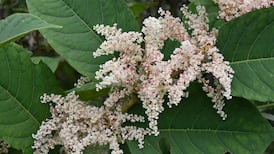Some Cosmos bedding plants I recently planted in our new garden have struggled to get going. Their leaves have yellowed and they look stunted. Any suggestions as to what the problem is? In my old garden I grew these very easily. Rachel O’L, Kilkenny
A fast-growing, floriferous, half-hardy annual, Cosmos bipinnatus is easily raised from seed sown under cover in spring. This very decorative member of the daisy family is great for quickly adding height and colour to a container display or summer border. It also makes an excellent cut flower. A wide range of varieties are available, with flowers in shades of pink as well as white, lemon-yellow and apricot.
Annual cosmos is typically very vigorous, so much so that the standard advice is to avoid planting it into too rich a soil in order to encourage flower production over an excess of leafy growth. That said, plants can become sometimes infected by diseases such as aster yellows or fusarium, which cause stunted growth and yellowing of the foliage. Like most members of the daisy family, this species loves full sun and a free-draining soil, so overwatering, or growing plants in wet, poorly drained soil or in deep shade can also cause similar symptoms.
There’s also a chance that your plants may be suffering from what’s known as lime-induced chlorosis. This happens when the soil has a high pH (a pH above 7), meaning it’s alkaline or high in lime.
READ MORE
Plants vary in their ability to grow well in these kinds of soils. Ericaceous plants such as azalea, pieris, camellia and rhododendron, for example, can only be grown in soils where the pH is quite acidic (ideally a pH of 5-6). But most plant species including cosmos are happiest when the pH is just slightly acidic to neutral, with a pH of 6.5-7.
In alkaline soils, however, an excess of lime can interfere with a plant’s ability to absorb phosphorus, iron and manganese as well as other nutrients, causing the symptoms you describe. So I’d suggest you test your soil’s pH, always a good idea with a new garden and something that can be done easily at home using a test widely available in most good garden centres. For accurate results, use a soil sample from an area that hasn’t been recently manured or fertilised.
Correcting an overly high soil pH is complicated and typically involves using products that acidify the soil, such as sulphur, aluminium sulphate and sulphur of iron, also known as ferrous sulphate. Mulching with pine needles or bark mulch are other solutions. But it’s very important that this is done carefully and cautiously as the amount required will depend upon the degree of alkalinity. Bear in mind, too, that making the soil too acidic can also have a negative impact on plant growth. Detailed advice on rhs.org.uk.
















